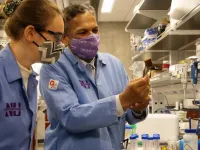(Press-News.org) Electrical engineers at the University of California San Diego developed a technology that improves the resolution of an ordinary light microscope so that it can be used to directly observe finer structures and details in living cells.
The technology turns a conventional light microscope into what's called a super-resolution microscope. It involves a specially engineered material that shortens the wavelength of light as it illuminates the sample--this shrunken light is what essentially enables the microscope to image in higher resolution.
"This material converts low resolution light to high resolution light," said Zhaowei Liu, a professor of electrical and computer engineering at UC San Diego. "It's very simple and easy to use. Just place a sample on the material, then put the whole thing under a normal microscope--no fancy modification needed."
The work, which was published in Nature Communications, overcomes a big limitation of conventional light microscopes: low resolution. Light microscopes are useful for imaging live cells, but they cannot be used to see anything smaller. Conventional light microscopes have a resolution limit of 200 nanometers, meaning that any objects closer than this distance will not be observed as separate objects. And while there are more powerful tools out there such as electron microscopes, which have the resolution to see subcellular structures, they cannot be used to image living cells because the samples need to be placed inside a vacuum chamber.
"The major challenge is finding one technology that has very high resolution and is also safe for live cells," said Liu.
The technology that Liu's team developed combines both features. With it, a conventional light microscope can be used to image live subcellular structures with a resolution of up to 40 nanometers.
The technology consists of a microscope slide that's coated with a type of light-shrinking material called a hyperbolic metamaterial. It is made up of nanometers-thin alternating layers of silver and silica glass. As light passes through, its wavelengths shorten and scatter to generate a series of random high-resolution speckled patterns. When a sample is mounted on the slide, it gets illuminated in different ways by this series of speckled light patterns. This creates a series of low resolution images, which are all captured and then pieced together by a reconstruction algorithm to produce a high resolution image.
The researchers tested their technology with a commercial inverted microscope. They were able to image fine features, such as actin filaments, in fluorescently labeled Cos-7 cells--features that are not clearly discernible using just the microscope itself. The technology also enabled the researchers to clearly distinguish tiny fluorescent beads and quantum dots that were spaced 40 to 80 nanometers apart.
The super resolution technology has great potential for high speed operation, the researchers said. Their goal is to incorporate high speed, super resolution and low phototoxicity in one system for live cell imaging.
Liu's team is now expanding the technology to do high resolution imaging in three-dimensional space. This current paper shows that the technology can produce high resolution images in a two-dimensional plane. Liu's team previously published a paper showing that this technology is also capable of imaging with ultra-high axial resolution (about 2 nanometers). They are now working on combining the two together.
INFORMATION:
Paper title: "Metamaterial assisted illumination nanoscopy via random super-resolution speckles." Co-authors include: Yeon Ui Lee*, Junxiang Zhao*, Qian Ma*, Larousse Khosravi Khorashad, Clara Posner, Guangru Li, G. Bimananda M. Wisna, Zachary Burns and Jin Zhang, UC San Diego.
*These authors contributed equally to this work
This work was supported by the Gordon and Betty Moore Foundation and the National Institutes of Health (R35 CA197622). This work was performed in part at the San Diego Nanotechnology Infrastructure (SDNI) at UC San Diego, a member of the National Nanotechnology Coordinated Infrastructure, which is supported by the National Science Foundation (grant ECCS-1542148).
An enhanced learning environment during the first five years of life shapes the brain in ways that are apparent four decades later, say Virginia Tech and University of Pennsylvania scientists writing in the June edition of the Journal of Cognitive Neuroscience.
The researchers used structural brain imaging to detect the developmental effects of linguistic and cognitive stimulation starting at six weeks of age in infants. The influence of an enriched environment on brain structure had formerly been demonstrated in animal studies, but this is the first experimental study to find a similar result in humans.
"Our research shows a relationship between brain structure and five years of high-quality, educational and social experiences," said Craig Ramey, ...
New research has shown that if people achieve and maintain substantial weight loss to manage their type 2 diabetes, many can also effectively control their high blood pressure and stop or cut down on their anti-hypertensive medication.
A weight management programme, developed by researchers at the Universities of Glasgow and Newcastle for the Diabetes UK-funded DIabetes REmission Clinical Trial (DIRECT), has proved effective at lowering blood pressure and reducing the need for anti-hypertensive medications, as well as bringing remission of type 2 diabetes.
The programme involves an initial 12 weeks on a nutritionally complete formula diet (low calorie soups and shakes) which will induce weight loss ...
Below please find summaries of new articles that will be published in the next issue of Annals of Internal Medicine. The summaries are not intended to substitute for the full articles as a source of information. This information is under strict embargo and by taking it into possession, media representatives are committing to the terms of the embargo not only on their own behalf, but also on behalf of the organization they represent.
1. Tai chi about equal to conventional exercise for reducing belly fat in middle-aged and older adults
HD video soundbites ...
UCLA HEALTH RESEARCH BRIEF
FINDINGS
A new study shows that tai chi mirrors the beneficial effects of conventional exercise by reducing waist circumference in middle-aged and older adults with central obesity. The study was done by investigators at the University of Hong Kong, The Chinese University of Hong Kong; Chinese Academy of Sciences; and UCLA.
BACKGROUND
Central obesity is a major manifestation of metabolic syndrome, broadly defined as a cluster of cardiometabolic risk factors, including central obesity, dyslipidemia, hyperglycemia, low high-density lipoprotein ...
A new study published in Proceedings of National Academics of Sciences finds that individuals who falsely believe they are able to identify false news are more likely to fall victim to it. In the article published today, Ben Lyons, assistant professor of communication at the University of Utah, and his colleagues examine the concern about the public's susceptibility to false news due to their inability to recognize their own limitations in identifying such information.
"Though Americans believe confusion caused by false news is extensive, relatively few indicate having seen or shared it," said Lyons. "If people incorrectly see themselves as highly skilled at identifying false news, they may unwittingly be more likely to consume, believe and share it, especially if it conforms to their ...
Phosphate pollution in rivers, lakes and other waterways has reached dangerous levels, causing algae blooms that starve fish and aquatic plants of oxygen. Meanwhile, farmers worldwide are coming to terms with a dwindling reserve of phosphate fertilizers that feed half the world's food supply.
Inspired by Chicago's many nearby bodies of water, a Northwestern University-led team has developed a way to repeatedly remove and reuse phosphate from polluted waters. The researchers liken the development to a "Swiss Army knife" for pollution remediation as they tailor their membrane to absorb ...
Very high atmospheric CO2 levels can explain the high temperatures on the still young Earth three to four billion years ago. At the time, our Sun shone with only 70 to 80 per cent of its present intensity. Nevertheless, the climate on the young Earth was apparently quite warm because there was hardly any glacial ice. This phenomenon is known as the 'paradox of the young weak Sun.' Without an effective greenhouse gas, the young Earth would have frozen into a lump of ice. Whether CO2, methane, or an entirely different greenhouse gas heated up planet Earth is a matter of debate among scientists. New research by Dr ...
Art Garfunkel once described his legendary musical chemistry with Paul Simon, "We meet somewhere in the air through the vocal cords ... ." But a new study of duetting songbirds from Ecuador, the plain-tail wren (Pheugopedius euophrys), has offered another tune explaining the mysterious connection between successful performing duos.
It's a link of their minds, and it happens, in fact, as each singer mutes the brain of the other as they coordinate their duets.
In a study published May 31 in Proceedings of the National Academy of Sciences, a team of researchers studying brain ...
Three groups (Dr. James Birchler's group from University of Missouri, Dr. Jan Barto's group from Institute of Experimental Botany of the Czech Academy of Sciences and Dr. HAN Fangpu's group from the Institute of Genetics and Developmental Biology of the Chinese Academy of Sciences) recently reported a reference sequence for the supernumerary B chromosome in maize in a study published online in PNAS (doi:10.1073/pnas.2104254118).
Supernumerary B chromosomes persist in thousands of plant and animal genomes despite being nonessential. They are maintained in populations by mechanisms of "drive" that make them inherited at higher than typical Mendelian rates. Key properties such as its origin, evolution, and the molecular mechanism for its accumulation in ...
While it is widely accepted that climate change drove the evolution of our species in Africa, the exact character of that climate change and its impacts are not well understood. Glacial-interglacial cycles strongly impact patterns of climate change in many parts of the world, and were also assumed to regulate environmental changes in Africa during the critical period of human evolution over the last ~1 million years. The ecosystem changes driven by these glacial cycles are thought to have stimulated the evolution and dispersal of early humans.
A paper published in Proceedings of the National Academy of Sciences of the United States of America (PNAS) this week challenges this view. Dr. Kaboth-Bahr ...




